The Boggy Isles
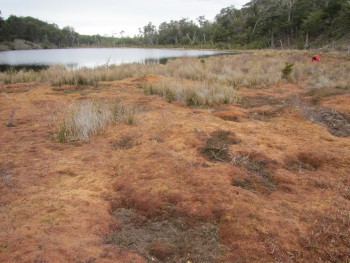
I used to think that bogs were rather drab and dismal places. They’re definitively damp, and nothing much grows there except… well, you know – boggy stuff. Some of that ‘stuff’ I identified tentatively as sphagnum moss, and the rest I dismissed as “some other kind of moss”. And who could possibly get excited about moss?
Well, lots of people, as it turns out; and me too, eventually.
It turns out that the flora of the Cape Horn National Park and UNESCO-appointed Biosphere Reserve consists very largely of boggy stuff – but before we go any further, we need to define both of those things. What are the boundaries of the Cape Horn National Park and what, pray, is a Biosphere Reserve?
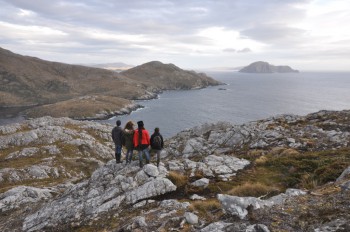
Well, the Park consists of the Wollaston archipelago and the Hermite Islands – which is to say that it is made up of that cluster of storm-swept specks which off-lie the more compact mass of islands into which this uttermost tip of the American continent has been broken. They occupy roughly 250 square miles of ocean.
As for the other thing – according to Wikipedia, a Biosphere Reserve is an area where the conservation of the local ecosystem is reconciled with its economic use. Bearing in mind that no one lives here and the only obvious economic activity is crab fishing, one’s first thought is that there could scarcely be much need for reconciliation between the two – but upon reflection, the biggest economic activity here is tourism.
Yes, we like to think of ourselves as being outside the main picture, but even yotties are capable of leaving their mark where they shouldn’t; and the cruise ships, which regularly disgorge a multitude of orange-lifejacketed passengers onto Isla Hornos, provide even greater scope for doing damage. Those feet might not do too much harm, provided they fall on the marked paths, but think of the damage that a wrecked ship could do. And what about a wrecked oil tanker? This national park is rated one of the 37 most pristine places in the world, but an oil spill could change all that in an afternoon. Presumably this is the sort of thing that the UN had in mind when they made their designation.
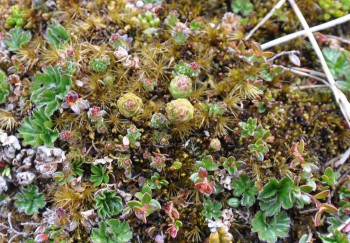
Before embarking on a description of the fascinating flora to be found in bogs I want to provide a clearer explanation of what is meant by that word. Basically, a bog consists of a thick pile of dead plant material which is too wet and too acidic to rot very quickly. This layer, which we know as peat, can be several metres thick, and – unless the place has dried out – it will have living plants growing on the top. Most of the plants are, indeed, mosses – I got that bit right – but there will often be other plants growing up through the bog or on adjacent rocks. As we got down on our hands and knees and took a closer look at this ‘boggy stuff’ I began to notice plants which seemed vaguely familiar, and I realised that the Welsh mountainsides where my parents liked to go for our holidays must have been partially covered with bogs. What wonders had I overlooked? What worlds trampled under foot?
During Mollymawk‘s whistle-stop tour of the Cape Horn archipelago, bogs became our obsession. Wherever we went, our eyes fell hungrily upon the feast of tangled tiny green and brown leaves carpeting the ground. In another place, at another time, we might have regarded the spongy moss as a nuisance, and certainly the scrub bushes sprouting through the soggy carpet would have been seen as nothing more than an obstacle to our intentions to scramble up the hillsides. Wherefore the change of heart?
It was all down to the presence of the Bog Woman.
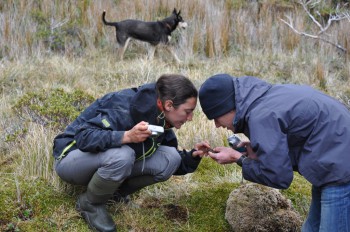
A brief, chance meeting at Iberá (in northern Argentina) a couple of years ago had left us with the vague recollection of a Chilean biologist; and Carolina, for her part, had been sufficiently interested in us to leave a message, shortly afterwards, on our Facebook page. What inspired me to respond after all this time I cannot say, but it was a good move. When she heard that we were about to sail round Cape Horn, the young woman sent back a message filled with equal mixtures of empathic joy and envy. It turned out that she had always longed to make this trip.
Carolina also filled us in on her background. She’d spent the past seven years living in Germany, studying at a university in Berlin. Her speciality was bogs – or mires, as she called them – and her Masters dissertation had revolved around the in-depth study of some boggy mires in Chile.
We couldn’t even remember what this woman looked like – but maybe that didn’t matter. It occurred to me that we were jolly lucky in being able to just nip round Cape Horn with hardly so much as a by-your-leave, and I decided that if a Chilean wants to see part of Chile and can’t get there under her own steam, it would be mean not to offer a ride. “We might be able to find room for you,” I said tentatively, “if you don’t mind slumming it.”
“I’d love to!” came the reply.
“There might even be some bogs for you to explore.”
“Well of course there are! That whole area is covered in mires.”
This came as news to me – I’d pictured the Cape Horn islands as being entirely barren lumps of grey rock – but it also settled the question of whether we would make room for a guest. By taking this bog-mad woman with us we could further both our own knowledge and the scientific knowledge of our host country. Carolina would be able to study the bogs and report on her findings, and we would be able to learn from her.
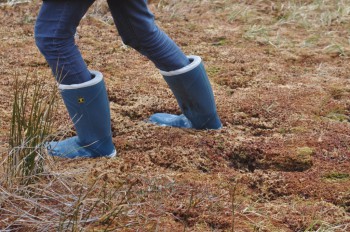
Our first foray into the local flora took place before we’d even embarked from Puerto Williams, when we took our expert to visit a local venue which we suspected of fitting the bill. Yes, it was a genuine mire, she told us enthusiastically. The spongy red-brown stuff was all sphagnum. (10 out of 10 for me!) Then she marked out an area, carefully lifted a section of the peat, and plunged her hands into the dark brown slythy stuff. A worm wiggled, exciting the scientist greatly. Apparently, it is rare to find such things in the acidic soil.
When we reached the Cape Horn archipelago we found that there were even more bogs than Carolina had anticipated. Indeed, whereas she had only expected to find bogs where the satellite images showed lakes and ponds, it seemed that every island was almost entirely covered in a thick blanket of peat.
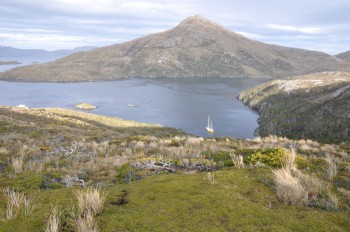
In some cases the plants which make up the peat-bog had begun growing around ponds which had formed in the hollows of the mountain slopes, and from there they had spread outward. In other cases the vegetation appeared to have built up, over long periods of time, on the rocks. The foundation, in this case, this was mosses and lichens.
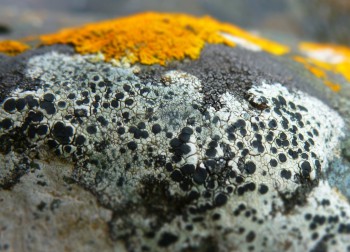
Lichens are a symbiotic relationship between a fungus and an alga. They are not classified as plants (although algae are plants), partly because they don’t have roots with which to take up nutrients and water. They feed exclusively through photosynthesis. Because they don’t need to be based on an organic substrate they can colonise even the bare mountainsides; and they do, in great abundance in the Cape Horn archipelago.
After the lichens came the mosses – or perhaps the two came together, because mosses also lack true roots and have no need of soil. In the bogs which Carolina had previously studied, sphagnum moss had ruled. Sphagnum can’t grow on bare peaks because it needs a very wet environment – and then it makes the water in the bog so very acidic that other plants are unable to survive. This was the case on the relatively sheltered island of Isla Navarino – here, the predominant flora was Sphagnum magellanicum – but on the wind-swept islands of Cape Horn there was none of this spongy, red-brown moss to be seen. Why not, we asked our tame expert? “Too windy,” she replied, “and too salty.”
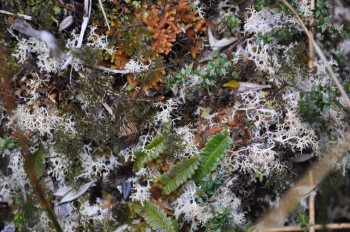
In the absence of the acid-loving and acid-making spag-bog (as your correspondent named it), other things have a chance. Had it not been for Carolina, we would hardly have given them a second glance, but now that we took a close look the variety was almost shocking. These seemingly barren isles with their impossibly harsh climate are absolutely carpeted from bottom to top with tiny spongy, prickly, spiky things, all of which seem to be competing frantically for space. I guess this is partly due to the lack of pollution, for the air hereabouts must be just about the cleanest in the world.
Having whet your appetite I’m now going to introduce you to a few of our new friends, beginning with the plant which is most abundant here.
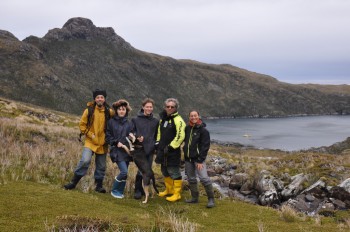 That’s not grass that we’re standing on; it’s Astelia pumilia, a three-bladed spiky thing about one inch in width. It’s everywhere, and although it doesn’t trouble the well shod walker it caused poor old Poppy-dog a lot of strife. Sometimes it grows over thick layers of peat, but it can also work its way over ponds – as can many of the other plants, including sphagnum. We certainly didn’t expect the islands of the Cape Horn archipelago to be bouncy!
That’s not grass that we’re standing on; it’s Astelia pumilia, a three-bladed spiky thing about one inch in width. It’s everywhere, and although it doesn’t trouble the well shod walker it caused poor old Poppy-dog a lot of strife. Sometimes it grows over thick layers of peat, but it can also work its way over ponds – as can many of the other plants, including sphagnum. We certainly didn’t expect the islands of the Cape Horn archipelago to be bouncy!
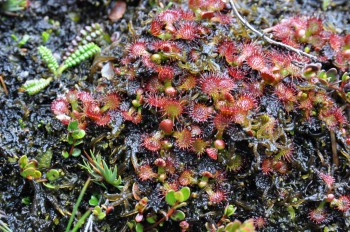 This is my favourite bog plant, seen here growing amongst brown liverworts. It’s a sun-dew with the Latin name of Drosera uniflora. Besides having the most beautiful leaves which appear to be beaded with raindrops, it also has a rather exciting habit: It eats meat.
This is my favourite bog plant, seen here growing amongst brown liverworts. It’s a sun-dew with the Latin name of Drosera uniflora. Besides having the most beautiful leaves which appear to be beaded with raindrops, it also has a rather exciting habit: It eats meat.
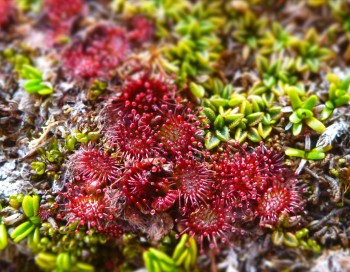 I guess that sounds rather macabre, particularly coming from a vegetarian, but one can’t help but be fascinated at the idea! Since we didn’t see a single fly, I can’t imagine how there came to be so many hundreds and thousands of sun-dews carpeting the wetter spots.
I guess that sounds rather macabre, particularly coming from a vegetarian, but one can’t help but be fascinated at the idea! Since we didn’t see a single fly, I can’t imagine how there came to be so many hundreds and thousands of sun-dews carpeting the wetter spots.
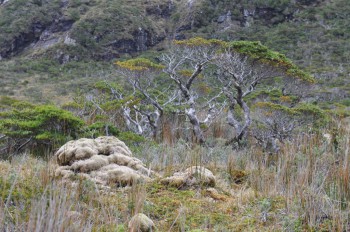 On the more sheltered leeward slopes we found huge clumps of moss of various sorts, and there were also small, gnarled trees.
On the more sheltered leeward slopes we found huge clumps of moss of various sorts, and there were also small, gnarled trees.
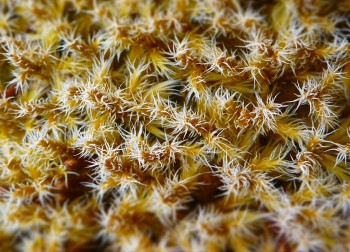 A close up of one type of moss.
A close up of one type of moss.
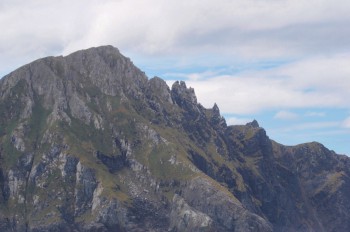 Even the very cliffs of Cape Horn are cloaked with moss, or with something of that sort.
Even the very cliffs of Cape Horn are cloaked with moss, or with something of that sort.
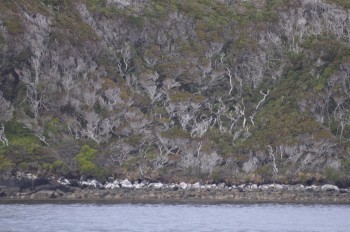 The forests of the Cape Horn region consist largely of three species of Nothofagus, one of which is evergreen. On the mountainsides above Puerto Williams this tree grows to a height of some sixty feet with a trunk which might measure three feet in diameter. We were astonished to realise that the little trees growing on the leeward shores of the Wollastons and the Hermites were of the same species. Here, they are twisted and bowed down, and few are more than twelve feet high.
The forests of the Cape Horn region consist largely of three species of Nothofagus, one of which is evergreen. On the mountainsides above Puerto Williams this tree grows to a height of some sixty feet with a trunk which might measure three feet in diameter. We were astonished to realise that the little trees growing on the leeward shores of the Wollastons and the Hermites were of the same species. Here, they are twisted and bowed down, and few are more than twelve feet high.
The white stuff on the rocks is a type of lichen which grows just above the high water line. I guess it likes a bit of salt.
Had we not been scrutinising the ground – had we been stomping along, intent simply on climbing to the summit – then we would probably have overlooked the fact that the same Nothofagus betuloides trees which grow in the forest and down by the shore are also growing on the peaks; but in this situation they are exposed to such terrible winds that all they can do is crawl along the ground like vines. Stunted vines at that.
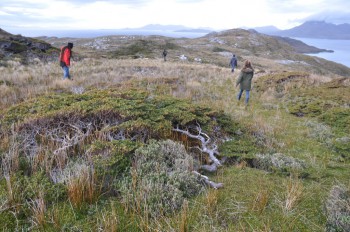 I would love to know how old these poor, oppressed trees might be. Perhaps they’re the same age as their tall and elegant brothers and sisters in the forests? The specimens in this photo have an especially disadvantaged background: Besides having to cope with hurricane force winds laden with salt spray and snow, they grew from seeds which evidently fell into the bog. Their roots are deep down in the peat, but some of them are actually growing through a foot or two of water. Mind you, at least they are never going to be blown down, which is the fate of many forest trees when the once-in-a-while, 80 knot storm finds its way over the mountains.
I would love to know how old these poor, oppressed trees might be. Perhaps they’re the same age as their tall and elegant brothers and sisters in the forests? The specimens in this photo have an especially disadvantaged background: Besides having to cope with hurricane force winds laden with salt spray and snow, they grew from seeds which evidently fell into the bog. Their roots are deep down in the peat, but some of them are actually growing through a foot or two of water. Mind you, at least they are never going to be blown down, which is the fate of many forest trees when the once-in-a-while, 80 knot storm finds its way over the mountains.
When walking across this terrain one has to be careful not to go tumbling down such holes in the bog. At one stage, Poppy disappeared for about half an hour and when she finally turned up she was sopping wet and very upset. We suspect that she’d spent the time struggling to get out of a bog hole.
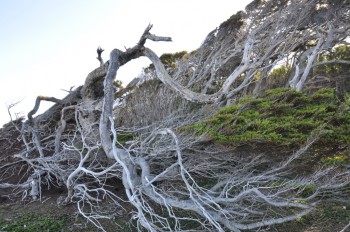 As we sailed north again and came amongst the islands less exposed to the worst of the weather, the vegetation changed. The trees on the windward shores were still ruthlessly bent and their foliage was shaven – they’d all had a convict hair cut – but on the leeward side the trees grew tall and there were flowers sprinkled at their feet.
As we sailed north again and came amongst the islands less exposed to the worst of the weather, the vegetation changed. The trees on the windward shores were still ruthlessly bent and their foliage was shaven – they’d all had a convict hair cut – but on the leeward side the trees grew tall and there were flowers sprinkled at their feet.
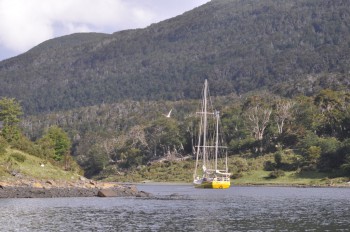
Whereas in the Cape Horn islands we had seen only seabirds and condors – the one sweeping over the waves and the other wheeling over the islands – in Isla lennox and Picton and on the north coast of Navarino there were little birds twittering at us from the bushes. Steamer ducks and dolphin gulls sat close to one another on their nests; blackish oyster-catchers piped their shrill whistle; and upland geese led their newborn goslings across the weedy mudflats. What a different world! Everything is relative, and on a summer’s day such as this, one could almost make believe that the Beagle Channel is as cosy as the garden of Eden.

HI SEE A LOT OF ANCIENT RUINS THROUGH GOOGLE MAPS IN ISLA HERMITE DID YOU COME ACROSS ANY ON THE COAST